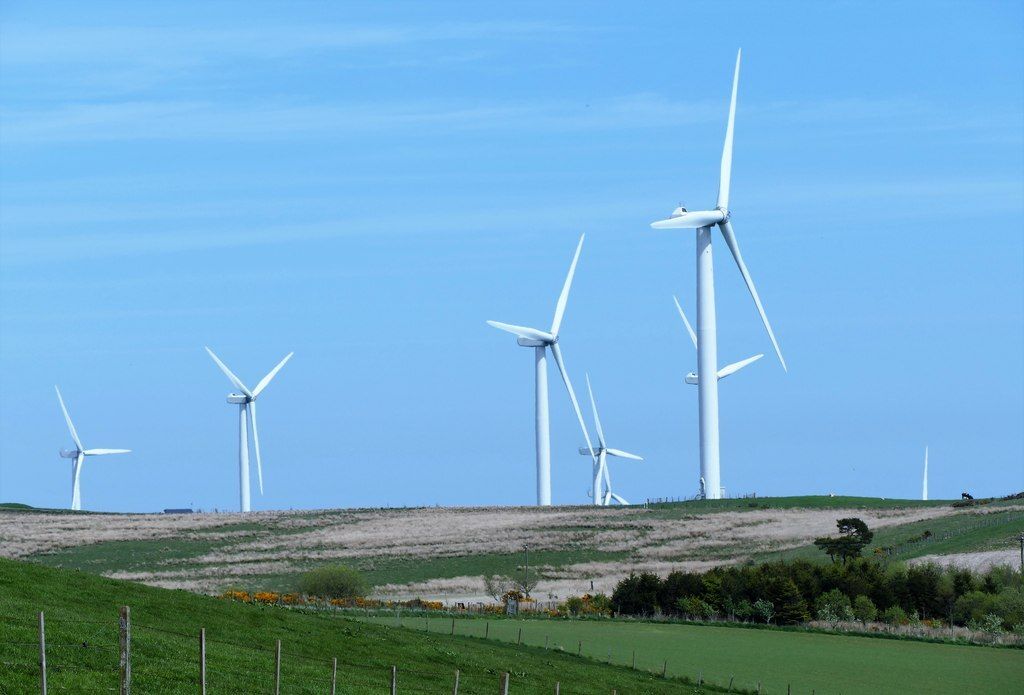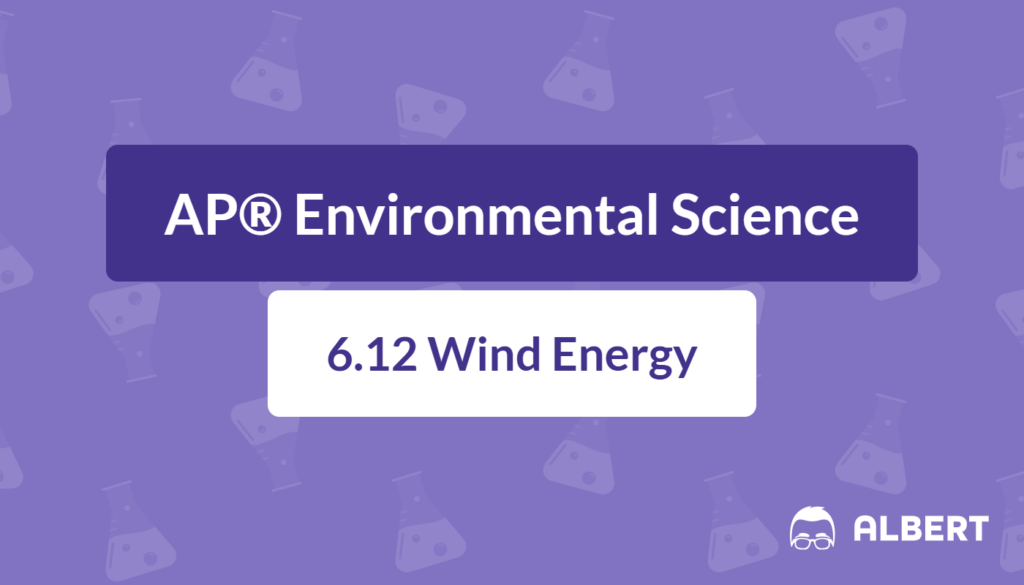What We Review
Introduction
Wind energy plays a vital role in modern power generation, especially as societies seek clean, renewable energy sources. Wind power comes from the natural movement of air, which can be harnessed using specially designed turbines. The following sections explore essential concepts of wind energy, the mechanisms behind wind turbines, and the environmental factors that shape the future of this promising resource.
Overview of Wind Energy
Definition of Wind Energy
Wind energy refers to the process of capturing the kinetic energy of moving air and converting it into electricity. Because wind is always circulating around Earth, this process provides an ongoing source of power. In AP® Environmental Science, wind energy is categorized as a renewable resource, similar to solar and hydroelectric power sources.
Importance of Wind Power in Energy Generation
Wind power is crucial today, owing to growing demand for sustainable energy that limits greenhouse gas emissions. When wind turbines produce electricity, they do not emit carbon dioxide directly. Therefore, they help reduce our reliance on fossil fuels and support global efforts to slow climate change. Furthermore, expanding populations worldwide need increasing amounts of electricity, which drives additional interest in wind power. Although many factors, such as the population growth model and the carbon cycle, influence energy choices, wind energy stands out for its reduced environmental impact compared to conventional sources.
Brief Overview of Wind Power Technology
Wind power technology consists of wind turbines, control systems, and electrical grids for distribution. First, turbine blades capture wind’s kinetic energy. Next, they rotate a shaft connected to a generator that produces electricity. Finally, through various transformers and transmission lines, electricity travels to homes, businesses, and other end users.
Concept Explanation:
- Wind energy is generated by the movement of air.
- Modern wind turbines have large blades and sophisticated mechanisms to maximize efficiency.
- Energy is transferred from the blades’ motion to a generator, where it is converted into usable electricity.
Illustrative Example — Concept in Action:
Imagine a wind farm built along a breezy coastline. Rows of sleek turbines face the prevailing winds. Each turbine’s blades rotate quickly, sending mechanical energy through a shaft to a generator. Finally, electricity flows through power lines, lighting up nearby cities, all thanks to the simple force of wind.

How Wind Turbines Work
Explanation of Kinetic Energy
Kinetic energy is the energy an object has due to its motion. In this case, air masses moving across Earth’s surface have kinetic energy proportional to their mass and velocity. When wind encounters a turbine’s blades, it transfers some of that energy, causing the blades to rotate.
Mathematically, wind power can be approximated by the formula:
P = \frac{1}{2} \rho A v^3,where
- \rho = air density,
- A = swept area of the turbine blades,
- v = wind velocity.
Mechanism of Wind Turbines
1. Blades Capture Wind
Wind turbines often have two or three blades made of lightweight materials. These blades are shaped to efficiently catch wind. When wind pushes against them, the blades turn in a circular motion.
2. Spinning a Turbine
As the blades turn, they rotate a drive shaft inside the turbine. This shaft is connected to a gear box that increases the rotational speed, optimizing it for electricity generation.
3. Conversion to Mechanical Energy
Inside the nacelle—the housing on top of a wind turbine tower—rotation is converted to mechanical energy, which drives a generator. As the generator spins, magnetic fields inside it create electrical current.
Steps to Generate Electricity from Wind
- Wind blows across the turbine’s blades.
- The blades rotate and turn a shaft connected to gears.
- The gears increase rotation speed for an electricity generator.
- The generator transforms mechanical energy into electrical energy.
- Electricity flows to transformers that adjust voltage for safe transmission.
- Power lines carry electricity to local grids and, eventually, consumers.
Illustrative Example — Step-by-Step:
- Suppose a steady wind of 8 m/s flows past a 40-meter-long turbine blade.
- Using the formula P = \frac{1}{2} \rho A v^3, the wind’s power can be estimated.
- If \rho = 1.225 ,\text{kg/m}^3 (standard air density at sea level) and A = \pi \times 40^2 ,\text{m}^2, then one can compute the theoretical power in watts.
- This power calculation informs engineers how much electricity the turbine might generate.
- The generated electricity then flows into the local power grid for everyday use.
Advantages of Wind Energy
Renewable and Sustainable Resource
Wind energy is renewable, because wind is continually produced by differences in atmospheric pressure and temperature. As long as the sun heats Earth, winds will exist. Therefore, wind power can be replenished naturally, unlike fossil fuels, which take millions of years to form.
Low Greenhouse Gas Emissions
Wind power generates nearly zero direct emissions. Consequently, this benefit significantly reduces greenhouse gases, helping nations achieve carbon reduction targets. Moreover, wind energy’s use does not deplete finite resources and therefore contributes to cleaner air quality.
Economic Benefits and Job Creation
Wind farm development creates jobs in manufacturing, installation, maintenance, and other related fields. In many regions, communities that host wind farms gain extra revenue via land leases and tax benefits. Additionally, unlike some other renewable energy technologies, wind power can grow in areas with vast open spaces, providing rural communities with new opportunities.
Concept Explanation:
- Wind power reduces long-term operational costs because there is no purchase of fuel source.
- Installing wind turbines nurtures a specialized labor market for technicians and engineers.
Illustrative Example — Cost Analysis:
- A community invests in a 10-turbine wind farm.
- Although initial construction costs are significant, the fuel (wind) is free.
- Over time, the farm recovers expenses through electricity sales and government incentives.
- Residents experience cleaner air, and local businesses benefit from the influx of skilled labor.
Environmental Considerations
Effects on Wildlife
1. Birds and Bats
Wind turbines can pose a threat to flying animals that collide with spinning blades. Certain bird species, including raptors, are especially vulnerable. Likewise, bats may be affected if they hunt in the area of a wind farm.
2. Mitigation Strategies
Many wind farms use acoustic deterrents for bats or modify turbine operations during peak migration. In addition, modern turbine designs minimize risks by using slower, more visible blade technology. Careful site selection, away from critical habitats, lowers bird and bat fatalities as well.
Land Use and Habitat Disruption
Onshore wind farms can require large tracts of land for turbine placement, so farmland or local ecosystems might be disrupted. On the other hand, some installations co-exist with agriculture, allowing crops or livestock grazing. Careful environmental impact assessments identify sensitive habitats in advance to reduce negative effects.
Noise and Aesthetic Concerns
Wind turbines do produce noise, typically from their blades and mechanical parts. While noise levels generally remain moderate, residents near turbines can find them unpleasant. Furthermore, communities sometimes resist turbines because of changes to scenic landscapes.
Concept Explanation:
- Environmental impact studies examine the suitability of areas for wind farms.
- Balancing the need for renewable energy with wildlife protection is a critical aspect of wind farm development.
Illustrative Example — Mitigation in Practice:
- Engineers plan a wind farm in a migratory bird corridor.
- Ecologists study flight paths and species behavior to find the safest turbine placement.
- When severe migration occurs, operations might temporarily halt.
- Acoustic deterrents and specialized blade coatings further reduce animal collisions.
The Future of Wind Energy
Technological Innovations
Researchers are continually improving turbine designs, including lighter materials and more efficient blade shapes. Offshore wind farms, sometimes situated miles into the ocean, harness stronger and more consistent coastal winds. Floating turbines are another emerging innovation, enabling power generation in deeper waters without fixed foundations.
Global Trends in Wind Power
Countries around the world are investing in wind power to meet renewable energy targets. Europe has been a leader, but other regions, including Asia and North America, are rapidly building new wind farms. New policies and technological advances can also help wind become a mainstay in countries with abundant coastal areas or expansive plains.
Potential Impact on Climate Change
Because electricity production using wind turbines does not rely on burned fuels, it emits minimal greenhouse gases. As demand for energy grows, wind power can replace or reduce reliance on coal and natural gas. Therefore, wind is expected to play a significant role in limiting the extreme impacts of climate change.
Concept Explanation:
- Innovations lower wind energy costs, making it increasingly competitive with conventional resources.
- Widespread adoption of wind power supports climate goals by reducing fossil fuel consumption.
Illustrative Example — Next-Generation Turbines:
- Engineers design a turbine with higher blade tips and advanced generators.
- This turbine performs better at low wind speeds, broadening its use to new regions.
- As it enters production, the system further reduces costs and greenhouse gas emissions.
Conclusion
Wind energy offers sustainable electricity generation by harnessing the kinetic energy of moving air. Wind turbines are vital in converting that motion into electrical current. Furthermore, wind power typically produces minimal greenhouse gases and can bolster local economies through job creation. However, it remains essential to address wildlife impacts and community concerns.
Wind energy is a beacon of hope for cleaner power generation and reduced carbon footprints. Given the urgent need to mitigate climate change, wind farms will likely become more common worldwide. Students of AP® Environmental Science can investigate how wind power and other renewable energy systems transform global energy use and helps shape an environmentally responsible future.
Key Vocabulary
- Kinetic Energy: The energy an object possesses due to its motion.
- Mechanical Energy: The energy associated with the motion or position of an object, often converted to electrical energy by generators.
- Renewable Energy: A power source replenished naturally over short timescales, such as wind or sunlight.
- Greenhouse Gas Emissions: Gases like carbon dioxide and methane that trap heat in Earth’s atmosphere, contributing to climate change.
- Mitigation Strategies: Actions taken to reduce adverse effects, such as limiting wildlife collisions at wind farms.
Sharpen Your Skills for AP® Environmental Science
Are you preparing for the AP® Environmental Science test? We’ve got you covered! Try our review articles designed to help you confidently tackle real-world AP® Environmental Science problems. You’ll find everything you need to succeed, from quick tips to detailed strategies. Start exploring now!
- AP® Environmental Science: 6.9 Review
- AP® Environmental Science: 6.10 Review
- AP® Environmental Science: 6.11 Review
Need help preparing for your AP® Environmental Science exam?
Albert has hundreds of AP® Environmental Science practice questions, free response, and full-length practice tests to try out.








